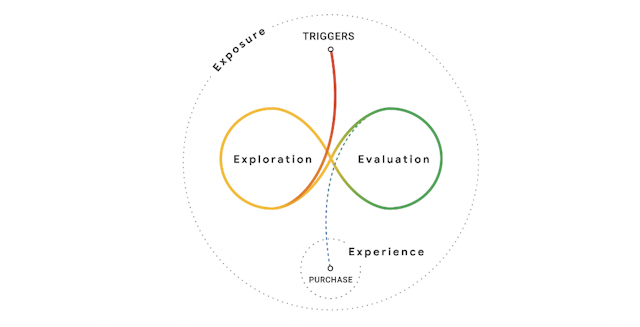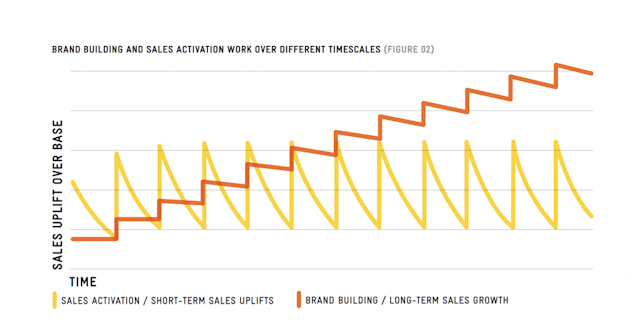How Google’s findings on purchase behavior impact the future of content marketing
Google recently released a research piece that analyzed the purchase behavior of consumers and subsequently discussed the findings regarding the buyer decision process. The article cited a “messy middle” – a purchase consideration loop that sits between triggers and purchase – which is where and how consumers explore products on an expansive basis and evaluate on a reductive basis.

Future of content marketing
On a fundamental level, this is not new thinking. We know the purchasing funnel is not linear. However, I am a fan of how elegantly Google has managed to paint the picture. Rather than a confusing chart with arrows headed in multiple directions we are presented with an infinity loop which eventually trails off to a purchase – consumers going back and forth between different areas of thought processes. ’The Messy Middle’ crystalizes a lot of what we already know in how difficult it is for brands to even try and attempt to manage the decision process for consumers.

This is a challenge that almost all brands face. Digital disruption has brought about so much change that a single consumer journey that encapsulates all users does not exist. And the industry must adapt.
High-consideration sectors such as automotive do not follow the usual purchase cycle, but Tesla is a unique example – they are showing us that direct sales are achievable and realistic, and that e-commerce is now a valuable channel for connecting with customers. We might be misled into thinking that only high-value products require high consideration. Take milk, for example; 10 years ago, buying a bottle of milk meant just that, however with the dairy alternatives market booming, we have seen a radical shift in the purchase behavior of products which used to be simple household staples. Consumers today spend a considerable amount of time trying to absorb information and deciding what is right for them. That’s why purchase behaviors are so important and critical to understand.
You need to review your marketing and sales strategy
Rather than viewing this change as a mountain to climb, brands should be excited. Now the buying decision process is more of a loop, and brands can continually surprise and delight their customers. Marketers must learn all that they can about their target customers’ passions, dislikes, and challenges. Armed with this knowledge, marketers can then make a personal connection and in turn deliver the best possible brand experience.
This is easier said than done. Research tells us that people are bombarded with 5,000 messages per day. The attention economy is a huge battleground for all. Brands are treading water just to stay in touch with the continually fragmented media space. Traditional advertising is facing many challenges where audiences can block or skip ads. Cutting through all this noise to be there for the consumer, when you need to be, is becoming an art form that requires dedicated resources and planning.
Of course, trying to navigate through this minefield, we can take heart in some of the constants. Les Binet and Peter Field have been researching marketing effectiveness for over a decade – and there has been no drastic change from their original work. They told us that brands must focus on brand building to grow their brands over the long term; that there is merit in trying to reach as many category buyers as possible; and continual brand building will help reduce the number of repetitions a consumer will make in the loop before deciding to purchase your brand. The ’why’ of these statements remains the truth. The ’how’ is the bigger question and content marketing can certainly help you get there.

How does the new buyer journey impact your content strategy?
There are three key areas that organizations should focus on:
- Understand what your consumers are looking and seeking to understand. Intersecting these specific needs with tailored content will ensure that you stand out and deliver a positive brand experience to the end consumer.
- Searching trends and social listening are good starting points.
- Factor in how close your content is to either a trigger point or a purchase point. For example: to generate triggers an automotive brand could push content on how environmentally friendly electric cars are; conversely for anyone closer to purchase, personalized content, dependent on location, should show how abundant charging stations are.
- Build systems to respond to these queries in real time to ensure that you stay as relevant as possible.
- Keep the audience in your brand’s ecosystem – build content to keep them interested and in the loop.
- Once you have exposed the audience to a piece of content, ensure that they are not stuck at a dead end and drop off. Fulfill the user requirement to explore and understand. Maximize the use of paid, owned and earned content and keep delivering content to the audience within your system.
- Create organizational agility.
- Campaign-based structures are slow and rigid. The consumer is always on and need states are continuous as well. Build agile teams to remove silos and create multi-functional experts, such as collaboration between your brand marketers, e-commerce, and data teams.
- This agile approach aligned to data-driven campaigns provides organizations with a platform to quickly respond to consumers’ intents and needs, particularly in social channels. It also allows you to prepare for the longer engagement phase and to measure the effectiveness of content across channels with clear test and learn principles.
To learn more, download and read about Capgemini’s Content Explosion offer. Feel free to also get in touch.
Asad Khan, senior consultant at Capgemini Invent.
Content by The Drum Network member:

frog
frog is a leading global creative consultancy, part of Capgemini Invent. Partnering with passionate leaders and visionary entrepreneurs, we apply creativity, strategy,...
Find out more
